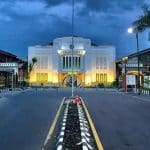Komodo is the largest lizard species in the world and includes endangered animals and must be protected.
Komodo Dragon
Komodo dragon includes members of Varanidea and Klad Toxicofera monitor lizards. Komodo dragon can grow up to 3 meters (10 feet) long and weigh up to 135 kilograms. This is what then makes the Komodo dragon as the largest lizard in the world.
Komodo has a tail that is the same length as its body and has approximately 60 sharp jagged teeth with a length of about 2.4 centimeters.
Komodo dragon’s saliva is often mixed with a little blood because almost all of his teeth are covered with gingival tissue. This tissue is torn when the dragons eat. Komodo has a long tongue, yellow and forked.
Male Komodo dragons have a larger size than females, and skin color from dark gray to red, while female dragons have a greener color.
Komodo dragon habitat
Reporting from Encyclopaedia Britannica (2015), Komodo dragons (Varanus Komodoensis) are only found on Komodo Island, Rinca, Flores, Gili Motang, and Gili Dasami, East Nusa Tenggara Province (NTT).
A study conducted by observing on four islands for a decade found that the Komodo dragon never left the land of its birth throughout life.
The researchers named Komodo as a homebody group or real home-based children. Dragons can only travel tens of miles and pass through heavy terrain and reach other areas.
The researchers moved seven adult Komodo dragons to another region as far as 13.7 miles but still on the same island during the study. Then it was moved to another island, separated by water and only 1 mile away.
The result is that the dragons that were moved to the island experienced a slight problem. Komodo cannot marry one of the other Komodo in his new home and has difficulty finding prey. This indicates the signs of incest in the Komodo dragon population.
Komodo Dragon Ecosystem
Komodo can survive in locations with sufficient water availability, safe shelters, lots of lush trees, and abundant food.
Komodo Dragon Population
Komodo dragon population in Komodo National Park (TNK) in West Manggarai Regency, NTT, until 2018 reached 2,897 Komodos. Komodo will dig a hole into storing eggs. The Komodo dragon’s eggs will hatch in April or May, and the young Komodo dragon will live in a tree for several months to avoid predators or older Komodo dragons.
Carnivorous animals
Komodo dragons include carnivores or meat-eaters, and hunt animals such as pigs, buffalo, deer, or horses. Even Komodo dragons sometimes become cannibals for other Komodo dragons. Komodo dragons eat their species or fellow dragons who are usually younger.
To find prey, the Komodo dragon will sneak up and attack suddenly to its victims. If the target is in range, it will immediately attack and immediately bite on the lower side of the body or throat. Komodo bite is very poisonous and can inhibit blood clots. Usually, the victim will feel weak from losing a lot of blood.
Komodo will find its prey when it is dying or shortly after death. Komodo dragons will find their prey using a tongue that can feel the smell of prey, dead or dying animals, at distances of up to 9.5 meters.
Promotional Content
You may also like:
8 rules that you must obey when visiting Komodo National ParkKomodo Island and Rinca Island – House of The Komodo Dragon


